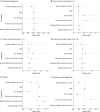Functional, Cognitive, Physical, and Vascular Outcomes 9 Years After Lacunar and Mild Cortical Ischemic Stroke
- PMID: 40834341
- PMCID: PMC12367423
- DOI: 10.1212/WNL.0000000000214018
Functional, Cognitive, Physical, and Vascular Outcomes 9 Years After Lacunar and Mild Cortical Ischemic Stroke
Abstract
Background and objectives: Data on outcomes after minor stroke, especially lacunar stroke, are lacking or based on short follow-up. Outcome differences between lacunar and cortical stroke remain unclear but may provide insights into small vessel disease (SVD) etiology and prognosis. We report on dementia, death, recurrent stroke, and function up to 9 years after lacunar or minor cortical ischemic stroke.
Methods: In this 9-year longitudinal observational cohort study, we prospectively recruited participants presenting with mild, nondisabling lacunar or cortical ischemic stroke to Lothian Stroke Services in Edinburgh, United Kingdom. At baseline, we collected data on sociodemographics, vascular risk factors, dependence, cognition, and brain MRI. At 9 years, we used questionnaires (including items from the Stroke Impact Scale) and hospital/general practitioner records to assess dementia, recurrent stroke, death, cardiac diseases, vascular risk factors, dependence, recovery, and functionality.
Results: We recruited 264 participants; clinical data were available for 243 participants (92%) (baseline mean age 67 years (SD 12), 42% female, 44% with lacunar stroke) and self-reported functional data for 96 (36%) at a mean follow-up of 8.5 years (SD 0.57). Dementia was diagnosed in 9.4% of participants with lacunar stroke and 12.4% of those with cortical stroke, with risk increasing with age (odds ratio [OR] 1.08; CI 1.030-1.130). Recurrent stroke occurred in one-third of all participants; risk increased with the presence of vascular risk factors (OR 2.27; CI 1.287-4.032). Participants with cortical stroke were more likely to die compared with those with lacunar stroke (χ2 = 8.2; p = 0.004). Age (OR 1.09; CI 1.051-1.133), male sex (female OR 0.40, CI 0.196-0.818), and white matter hyperintensities (OR 1.36; CI 1.112-1.664) increased risk of death. Moderate/severe disability was reported by 12% of participants and cognitive concerns by 49%-55%. Affected limb recovery and balance were worse after lacunar stroke (W = 705.5, p = 0.00).
Discussion: Long-term outcomes after minor stroke were frequently suboptimal and varied by stroke subtype, highlighting the lasting impact of both lacunar and mild cortical ischemic strokes on quality of life. Improving long-term outcomes after mild stroke remains an important target for refining clinical care and shaping future research directions.
Conflict of interest statement
V. Cvoro reports grants from NHS Research Scotland and Chest, Heart, Stroke Scotland, which funded the study. J.M. Wardlaw reports grants from Chest, Heart, Stroke Scotland and grants from the Fondation Leducq, UK Medical Research Council, Stroke Association, Alzheimer's Society, and British Heart Foundation. All other authors report no relevant disclosures. Go to
Figures





References
Publication types
MeSH terms
LinkOut - more resources
Full Text Sources
Medical
